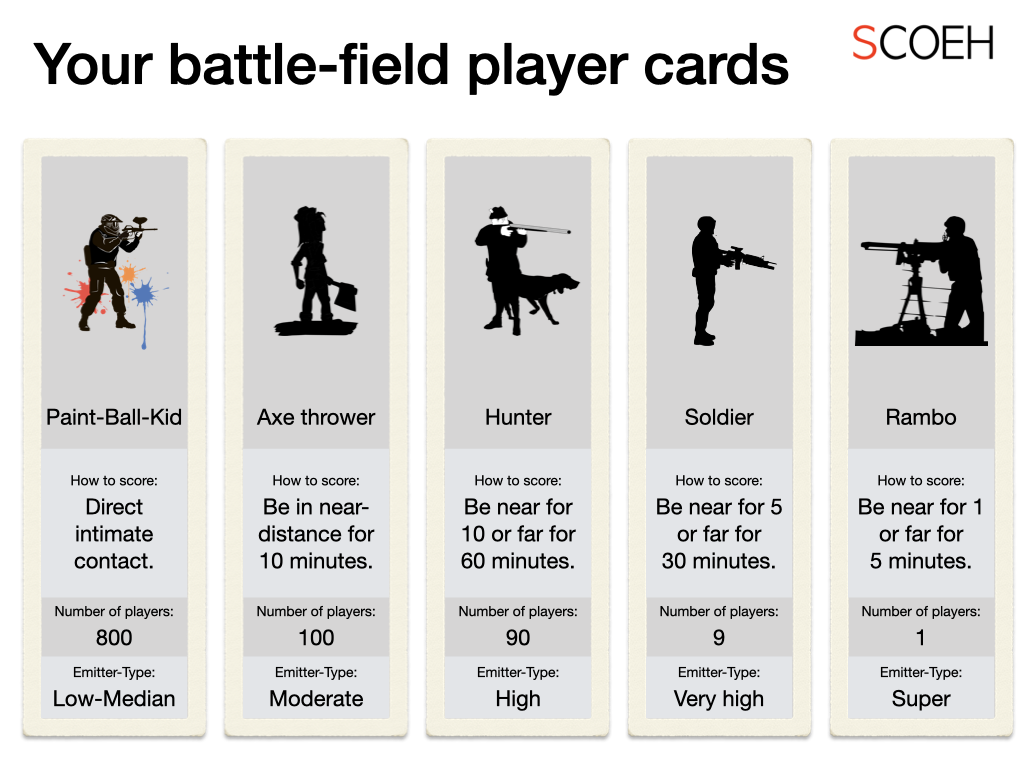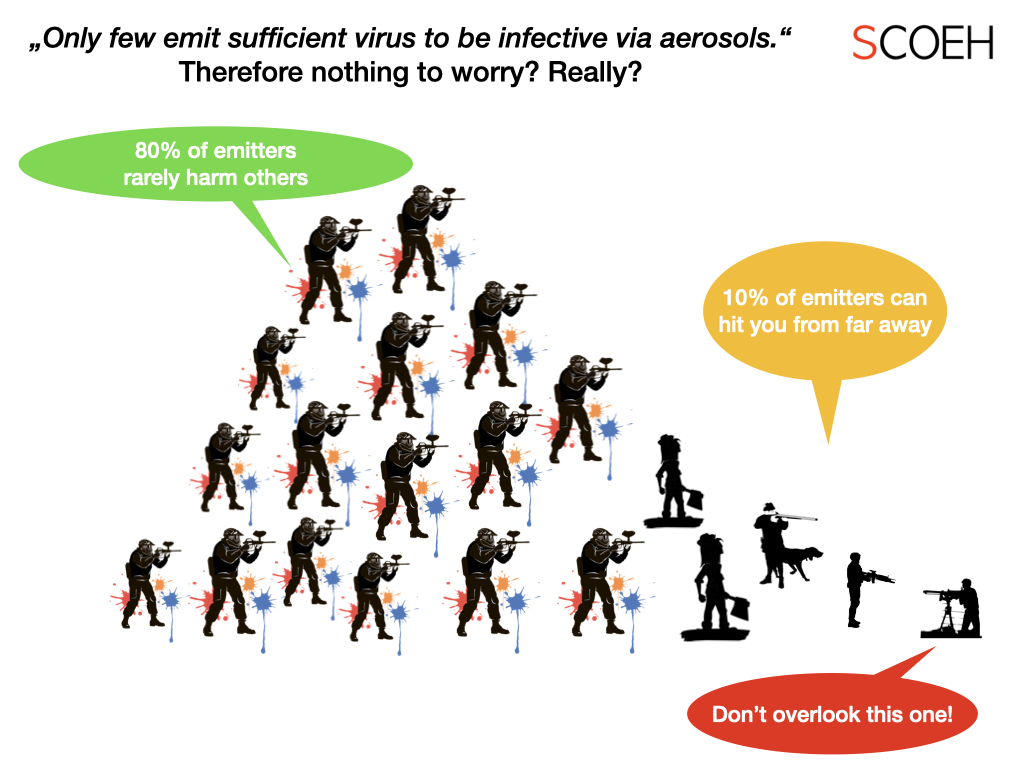I was recently contacted by a soldier who was trying to understand why the virus continues to spread rapidly even though my research suggests that those having the possibility to transmit the virus to others are rare. I answered with a battle-field analogy.

Your task: define an optimal defense strategy.
Your strategy to win this game is to focus on the soldiers while not totally ignoring the other adults. But we see in the current pandemic that many focus on strategies that assume that all infected people are equal, and they take the „average“ enemy soldier as the one to beat – and thus suggest a strategy that works against kids with paintball guns. OR they assume all are Rambos and lock up everybody at home. We are loosing the battle against the Corona virus because we do not account for the different „weaponization” of the infected people.

So what is behind these analogies:
1) The virus load is very unevenly distributed, i.e. how much virus an infected person has in its bodily liquids such as the lung lining liquid varies strongly. Only few have very high virus levels (billions of viruses per millilitre), many have moderate (hundreds of thousand) to low numbers of viruses (a few thousand). Worse, infected people carry the highest viral load at a moment when they have no or only moderate symptoms and thus are still socially active.
2) Two main forms of transmission seem to play a role – large droplets released during a „spraying-like“ process, and small droplets that are more like a fog or cloud. In aerosol physics, all these droplets flying in the air are called „aerosols“ (which is defined as matter and liquid dispersed in the air) while medical researchers often call the large ones „droplets“ and the small ones „aerosols“. However, there is a continuum between these two modes.
-> The large droplets play a role whenever distances cannot be respected. These droplets can be as large as several hundred micro-meters. One single droplet from a high virus carrier can be sufficient to infect a person. About 20% of the population has a sufficiently high virus load to be considered relevant for this spray-process (In the battle-field analogy, these would be axe throwers), those with highest virus load carry so much that one single droplet of 100 µm is sufficient to infect others.
-> The small droplets (those often referred to as aerosols) are important in closed rooms. These droplets can stay for hours airborne and thus over time an infected person can fill a room with virus-loaded aerosols. Here the number of people being important for the transmission is even smaller. About ten percent of the infected population can release sufficient virus into the air to pose a problem for indoor air environments in the form of aerosols. These can infect others both, in close contact with spray droplets and also on distance. The top emitters emit so much aerosol that it takes litte time to fill a small room
-> The activity. Speaking quietly increases the aerosol release by a factor of 10, speaking loudly increases this again about ten-fold (more and larger droplets), while exercising will increase the exhaled aerosol up to five-fold (or more for a very brief moment). So the worst you can have is a super-emitting person singing or shouting and exercising for a long time. We know this from super-spreading events in choirs, Yodelling-concerts and fitness-classes.
What are the battlefield equivalents? The worst that can happen is to have many people in a crowded place with poor ventilation and all of them being physically active and singing or shouting heavily (such as in a disco). This will generate a „super-spreading event“. This is like a battalion walking during a battle upright in T-shirts over an open field towards a forest. One enemy soldier with an assault rifle will be sufficient to take them all out, and also an enemy with a axe can cause casualties.
What about super-spreading? We rarely see an entire battalion walk in front of a machine gun (a mass-spreader). Much of the spreading happens when a super-emitter meets during his or her infectious period with friends and coworkers in small groups (a serial-spreader). These encounters are like Rambo walking around with a machine gun and taking out one platoon after another – together summing up to a super-important spreading series.
3) Prevention works best if taking into account the distribution of „weapons“. What are strategies to reduce the viral transfer (thus the chances of your soldiers to get hit by a bullet)?
-> The best prevention of aerosol-build-up in a room is to catch the aerosols at the source. Thus, wear masks, if possible surgical masks or even respirators. Simple face coverings are not very efficient in both directions. They help a bit but mostly against large droplets just like armour made of thick oak boards will catch the arrows and axes but not the bullets. In this analogy, surgical masks are your personal armour and professional grade respirators are steel plates.
-> Once you have the aerosol in the air, you can remove it by ventilation, but it takes a lot of ventilation. Air filtration also works as long as you have a good filter and a high air flow.
-> You can also dilute the aerosol by increasing the volume. So you meet with other people in large rooms.
-> You can reduce your personal dose by reducing the duration of time spent with others in a room.
-> You can avoid going to indoor places where people exercise and shout a lot.
-> You reduce the number of people meeting in indoor environments.
-> You reduce meetings between people who are from different groups.
There are more strategies that decision makers can take.
-> Spot those with machine guns or assault rifles and try to take them out. In other words, spot those with a high viral load (a low CT-value in the the PCR-test) and put all its contacts asap into quarantine.
-> Prevent groups from walking unprotected in front of a soldier or Rambo-card (mandate good masks and distance rules for gatherings of all sizes).
-> Provide respirators (FFP2, N95) to those interacting with potential Rambos (e.g. staff in testing centres and COVID-19 hospital units), or use technical installations to separate them from those who may infect them.
Finally, we must not release our guard. Just because nothing happened when we met an infected person does not mean our safety measures work. Just because splash guards protect us from paintballs does not mean that they work against real guns.
